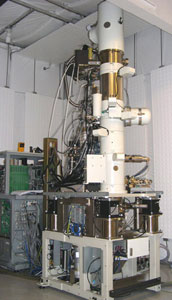|
Lehigh Researchers Set To Become Pioneers Of The Nanoworld
What the Hubble telescope has done for the discovery of distant galaxies, an aberration-corrected electron microscope will do for exploring the nano- world. Lehigh is the first and only university in the world to have two of these state-of-the-art instruments: a JEOL 2200FS transmission electron microscope (TEM) and a VG HB 603 scanning transmission electron microscope (STEM). Funding for both of these instruments has been provided primarily by the National Science Foundation (NSF). Up till now, the resolution of electron microscopes has been limited by the width of its electron beam. The problem lies with a series of lenses that focus the beam onto the sample. The outer extremities of these lenses tend to focus more strongly than their centers, limiting the beam width to 1-2 nanometers i.e. the width of approximately 5-6 atoms. An aberration corrector works on the last of these lenses, known as the objective lens, by measuring the amount of ‘over-focus' and with the help of a sophisticated feedback mechanism adjusts the beam accordingly. The resulting beam is only a tenth of a nanometer wide i.e. half the width of an atom. “It's like fitting the microscope with a new pair of reading glasses,” explains Chris Kiely, Director of the Nanoscale Characterisation Laboratory in the Department of Materials Science and Engineering, “giving it 20:20 vision.” This microscope can be remotely controlled and users from other universities will be able to drive the instrument via a special website. It took over a year just to prepare the room for the microscope. Both the 2200FS and the VG603 are extremely sensitive to external magnetic and electric fields, air vibration, and small fluctuations in temperature. Even the presence of an operator can affect the beam. The operator must leave the room and drive the instrument using a control panel housed in an adjacent room. New discoveries that will inevitably be made using these new microscopes will undoubtedly raise the research profile of Lehigh University, such as the discovery of Dillon-Harmer complexions. Our goal is to keep Lehigh as one of the leading electron microscopy centers in the world and now, with the help of the NSF, we have an unparalleled suite of instruments to offer to our students and faculty. For further information contact: Dr Christopher Kiely, Professor of Materials Science at Lehigh University Tel: 610 758 4291 Email: chk5@lehigh.edu
home ::: what is electron microscopy? ::: see the scopes ::: cool magnified images ::: take a guess ::: contact us |
